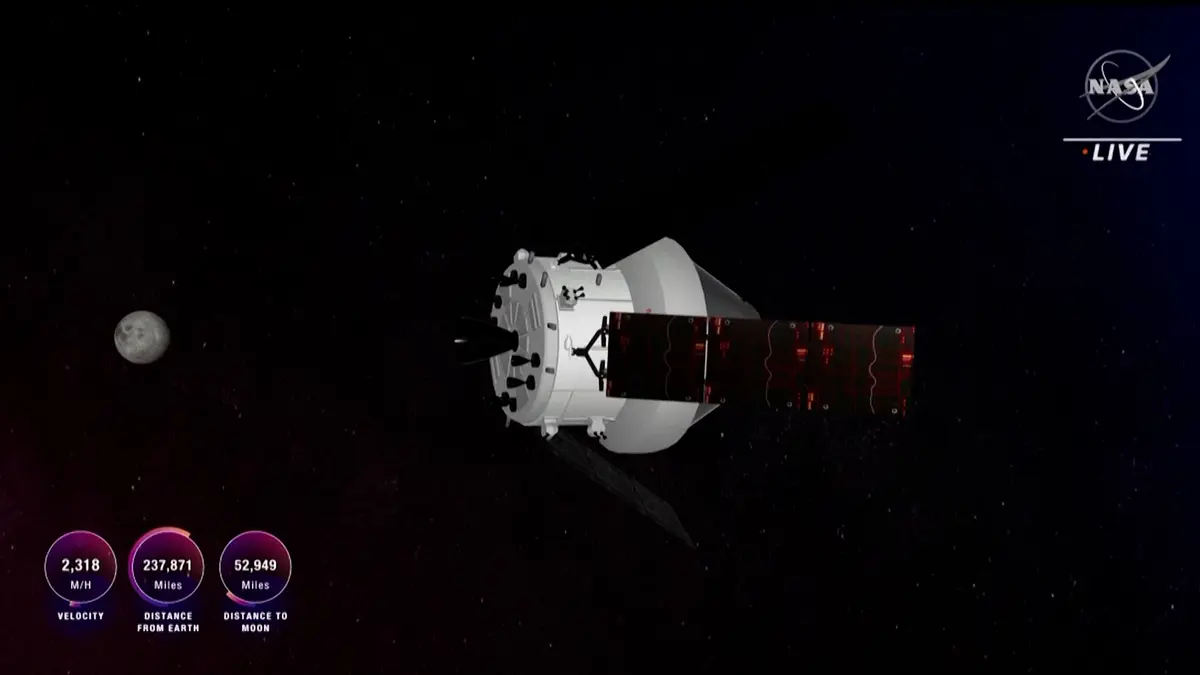On Monday, December 5, the next maneuver will guide the spacecraft on its way back to Earth.
Yesterday at 22:53 CET, the Orion spacecraft completed a 105-second powered maneuver (Δv = 138 m/s) to leave the DRO’s orbit. A corrective maneuver followed today at around 04:53 CET, and on December 5, the next maneuver will guide Orion on its way back to Earth. pic.twitter.com/rwh3Df5Bjf
— Michal Vaclavik (@Kosmo_Michal) December 2, 2022
“We have left lunar orbit! Orion fired its main engine today (Thursday) to leave a distant retrograde orbit and head toward Earth,” the US National Aeronautics and Space Administration (NASA) announced.
Currently – that is, Friday after noon our time – we are on the 16th day of the mission, and the Orion ship is now just over 370,000 kilometers from Earth.
Duration of mission: 15 days, 23 hours, 47 min
Orion is 234,429 miles from Earth, 82,456 miles from the Moon, with a cruising speed of 2,404 mph.
P: 232352, -39130, -36199
V: 128, 2125, 1117
Or: 288º, 128º, 144º
What is this? https://t.co/voR4yGy2mg #TrackArtemis pic.twitter.com/HfkZx7ZdYz— Orion spacecraft (@NASA_Orion) December 2, 2022
The Orion module, launched using an SLS rocket on Nov. 16, 2022, has been in a distant lunar orbit since Friday, Nov. 25.
A rocket to the moon took off, NASA showed our planet from the Orion board
Science and school
Multiple mission challenges including return
Before the three-meter-high Orion, which can accommodate up to four astronauts on future missions (there are now three mannequins on board), entered a distant orbit, it also undertook a motor maneuver, during which, on the contrary, , has skimmed very close to the lunar surface.
Last week, during its planned trajectory, the module successfully flew over to the opposite side of our natural satellite and came within about 130 kilometers of its surface.
Orion whizzed by just 130 kilometers from the lunar surface
Science and school
The module then reached a point 434,523 km from Earth on Monday, November 28, in its orbit around the Moon. This was a record because no other spacecraft built for a future human crew had ever come this far from us. At that moment, the craft was 64,374 km beyond the far side of the Moon.
“On Saturday, Nov. 26, Orion broke the original distance record for the first time for a space mission designed to carry people into deep space. The previous record was set by the Apollo 13 mission in 1970. At that time, the mission with real humans on board reached the maximum distance of 400,171 kilometers from our home planet,” NASA chief Bill Nelson summarized.
The Orion module has set a new distance record from Earth. It passed Apollo 13
Science and school
During that time in far orbit, NASA tested the craft’s various systems, which according to Reuters went “extremely well.” The goal is to test whether the ship will be able to carry astronauts to the moon and then back to earth.
If this unmanned mission is successful, the module will reach the Pacific Ocean on December 11 at 18:40 CET. Orion’s return to Earth will be the most critical part of the test mission.
According to a summary of the CNN news station, the module will enter the upper layers of the earth’s atmosphere at a speed of about 40 thousand kilometers per hour. The protective shield will have to withstand a temperature of almost 2800 degrees Celsius. The atmosphere will slow Orion to approximately 300 mph (482 km/h) and the parachute system, then to a maximum of 20 mph (32 km/h) before it hits the Pacific.
Just 30 minutes before touchdown, the important European ESM service module will separate from Orion and “not survive” the return, but burn up in Earth’s atmosphere, according to the European Space Agency (ESA). The main engine of the Orion spacecraft is located on the ESM attack module.
The launch of the most powerful rocket damaged the launch pad. He ripped off the elevator doors
Science and school
If all goes according to plan, a manned craft could fly around the moon in 2024 on the Artemis II mission, while NASA plans to land two humans on the lunar surface by the end of 2025 on the Artemis III mission.
The Artemis program should ensure not only the return of astronauts to the moon, but within its framework a long-term lunar colony should be established as a stepping stone for future flights to Mars.
Rashid still has to wait. The Falcon 9 rocket did not reach the moon
Science and school

